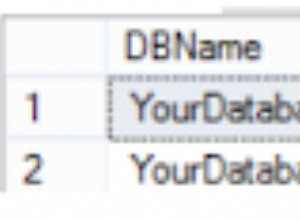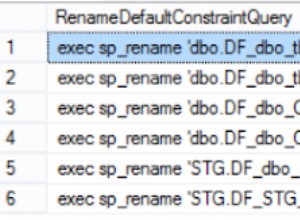Diese Abfrage ergibt die Anzahl für jede Zeile:
SELECT allocation, d, count(*) OVER (PARTITION BY allocation, part ORDER BY d) AS c
FROM (
SELECT allocation, d,
d - row_number() OVER (PARTITION BY allocation ORDER BY d) AS part
FROM t
)
ORDER BY d;
Sie können dann danach filtern, um die Anzahl für eine bestimmte Zeile zu finden:
SELECT c
FROM (
SELECT allocation, d, count(*) OVER (PARTITION BY allocation, part ORDER BY d) AS c
FROM (
SELECT allocation, d,
d - row_number() OVER (PARTITION BY allocation ORDER BY d) AS part
FROM t
)
)
WHERE d = DATE '2015-01-05';
Erklärung:
Die abgeleitete Tabelle wird verwendet, um verschiedene "Partitionen" part zu berechnen für jedes Datum und jede Zuordnung:
SELECT allocation, d,
d - row_number() OVER (PARTITION BY allocation ORDER BY d) AS part
FROM t
Das Ergebnis ist:
allocation d part
--------------------------------
Same 01.01.15 31.12.14
Good 02.01.15 01.01.15
Same 03.01.15 01.01.15
Same 04.01.15 01.01.15
Same 05.01.15 01.01.15
Good 06.01.15 04.01.15
Das konkrete Datum, das von part erzeugt wird ist irrelevant. Es ist nur ein Datum, das für jede "Gruppe" von Daten innerhalb einer Zuordnung gleich ist. Sie können dann die Anzahl der identischen Werte von (allocation, part) zählen mit dem count(*) over(...) Fensterfunktion:
SELECT allocation, d, count(*) OVER (PARTITION BY allocation, part ORDER BY d) AS c
FROM (...)
ORDER BY d;
um das gewünschte Ergebnis zu erzielen.
Daten
Ich habe die folgende Tabelle für das Beispiel verwendet:
CREATE TABLE t AS (
SELECT DATE '2015-01-01' AS d, 'Same' AS allocation FROM dual UNION ALL
SELECT DATE '2015-01-02' AS d, 'Good' AS allocation FROM dual UNION ALL
SELECT DATE '2015-01-03' AS d, 'Same' AS allocation FROM dual UNION ALL
SELECT DATE '2015-01-04' AS d, 'Same' AS allocation FROM dual UNION ALL
SELECT DATE '2015-01-05' AS d, 'Same' AS allocation FROM dual UNION ALL
SELECT DATE '2015-01-06' AS d, 'Good' AS allocation FROM dual
);




